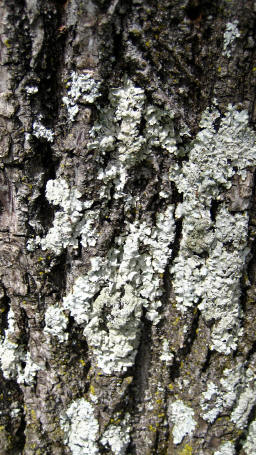 (5/30) Some years ago, I became aware of numerous alien-looking circles growing on the truck and branches of an ornamental crab apple tree growing in my yard. These perfect circles ranged in diameter from half an inch to three inches and exhibit three dimensional architectural wrinkly surfaces colored in pale green, gray, and cream. Thinking them parasitic, and thereby damaging to the tree, I set out to identify them in anticipation of their removal. Boy, was I wrong! These weird structures are lichen. Lichen mostly are benign and can be considered even beneficial. Contrary to common opinion, it is not true that lichen will kill a tree nor do they indicate a tree is dying.
(5/30) Some years ago, I became aware of numerous alien-looking circles growing on the truck and branches of an ornamental crab apple tree growing in my yard. These perfect circles ranged in diameter from half an inch to three inches and exhibit three dimensional architectural wrinkly surfaces colored in pale green, gray, and cream. Thinking them parasitic, and thereby damaging to the tree, I set out to identify them in anticipation of their removal. Boy, was I wrong! These weird structures are lichen. Lichen mostly are benign and can be considered even beneficial. Contrary to common opinion, it is not true that lichen will kill a tree nor do they indicate a tree is dying.
Lichen are unique complex organisms that construct three-dimensional structures found on the limbs and trunks of trees, rocks, and other natural and manmade surfaces. They cover the trees around my home and various items in my gardens including my deck’s composite railings, vintage cast iron fencing, cast iron handrails, garden stones, and large rock features.
The lichen that completely covered my deck railing were easily removed with a soaking, a brushing, and a strong water spraying. Water blasting is the best nontoxic way to remove unwanted lichen. These I found living on a dwarf Stewartia tree trunk that was severely infested with scale. Unfortunately, after an insecticide was sprayed to treat the scale, the lichen did not survive and were no longer viable. Sadly, the poor lichen were innocent victims of a situation created by the scale.
It seems that lichen do not care for stones or rocks surrounded by concrete mortar presumably due to the chemical nature of concrete, nor do they like painted surfaces. Yet they covered my composite deck railings. Otherwise, they indeed are everywhere in my garden. Some are solo circles, others form linear adjacent circles or colonies massed together, but most with always round wrinkly components. See photos.
Lichen are found everywhere; they cover about 7% of the earth’s surface. Some grow slowly, others faster, as much as three feet a year. Some can live for thousands of years. They are found in deserts and cold climates. Some Antarctic lichen have been estimated to be up to five thousand years old. Because of their longevity, mature undisturbed lichen can be used to date architectural and archeological areas.
Lichen are a mutually beneficial relationship or partnership between fungi and green algae, a form or structure unlike any other organism. The outer crinkly surface is composed of strands of fungal hyphae, the filaments that make up the mycelium filament network of fungi, interspersed with strands of algae. This relationship is symbiotic; in other words, beneficial to both parties.
The lichen fungal partner becomes dependent upon the algae and cannot live off decaying matter as do other fungi. The fungi provide the home for the algae via their structure, and the algae provide food through photosynthesis from water and chemical nutrients absorbed from the air. This makes lichen very sensitive to toxic chemicals and air pollution. They can serve as valuable bio-indicators of pollution and reflect a clean environment when present. They are declining in areas where air pollution is present. For example, California’s lichen have been hard hit by smog. Fortunately, lichen are hardy and recover if given a chance. They are extremely drought tolerant. There are over 18,000 species of lichen.
Over 700 chemical compounds have been isolated from lichen, and that is believed to be why they are not eaten by insects or birds. They exist in all climates and can be found on rocks in the arctic and in deserts. Lichen do not have roots or vascular tissue. Genetic studies a few years ago examined the genome of the common Wolf lichen found in the US, Canada, and Europe and determined that they contained three fungi. This upended and challenged the long-held view that all lichen were made up of only one alga and one fungus.
Many birds use lichen as nesting material. Some lichen have antibiotic properties and have been used since prehistoric times to dress wounds or as tonics or laxatives. They can be used to form dyes and various coloring pigments. Lichen do have an undesirable downside because they can overgrow roof areas weakening shingles. They can retain moisture and may cause deterioration. In some commercial settings, their presence can occur as a result of nitrogen and sulfur dioxide often found in factory areas that burn materials. Lichen can lead a double life in some settings. For the most part, they do not cause damage and just exist keeping to themselves. I find them attractive decorations on rocks in my gardens.
Read other articles by Connie Holland